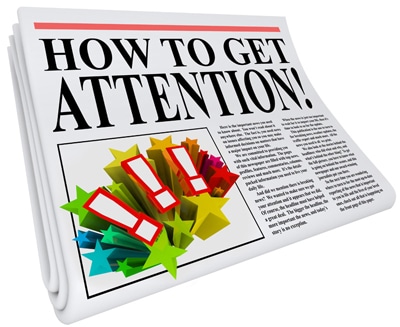The Headline Is the Most Important Piece of Any Ad – Whether In Print or Online
You have a limited amount of time to get someone’s attention and either a headline or an image is what you need to think about. If an image can convey the same information as the headlines, to the same target audience, then that may be a better choice, but for now, let’s focus on headlines.There are basically three (3) types of headlines:
- Self Interest – something that the consumer is already thinking about or needs.
- News – this would include current events and happenings.
- Curiosity – saying something that is curious to the consumer.
Which type of headline do you think is the most effective? If you chose #1, you’re right. People are more responsive to self-interest headlines, and we would say, much more responsive. Make sure you know who your target audience is, and think of what they are thinking.
If you’re a doctor, and the name of the practice is the headline, then what you’re accomplishing is making people aware of your name. A man or woman with back pain isn’t thinking about your name, they are thinking about their back. So, “Back Pain” is a headline that will get more attention from your target audience.You can also put all three types of headlines together to make it more appealing and powerful. For example, “New Back Pain Remedy” uses news, self-interest and curiosity.
Now let’s talk a little about format. If you ask a question, then people may pause for a few seconds to answer it, but then they will actually move on, even if it appeals to them. For example, “Do You Have Back Pain?” Most people will answer the question, yes or no, and move on to something else, even if they answer yes.
Here is a better format: “Where Is Your Pain?” with a list of places they may be feeling pain. This format gets the reader or viewer to drill down a little to answer the question. This type of headline is much more engaging.
We talked about the Problem and the Solution already. So, try to get the problem in your headline, with the self-interest of your target audience, and a question that lures them into the rest of the ad. When they realize you have identified their pain, they also will realize that you probably have something to do with fixing it. That, in itself, will get them to look for your solution.
If you have an image that will do that, place the image above the headline. Many times people will look at an image, then the headline. If your message is below the image and the headline, you want them to read your message and find your solution.
If the image is above the headline and catches their eye, they will most likely read the headline, and their eye is moving in the direction you need it to go. If the headline is above the image, half the time they will go back to read the headline, taking their eyes away from your message and solution. You can easily see the difference, and the difference that will make to the effectiveness of your campaign.




